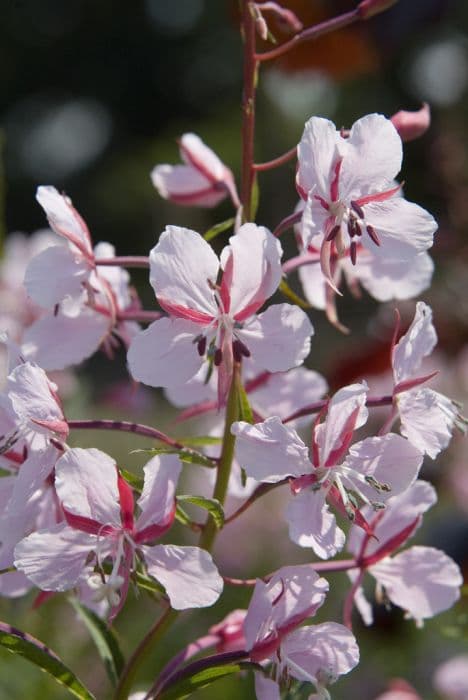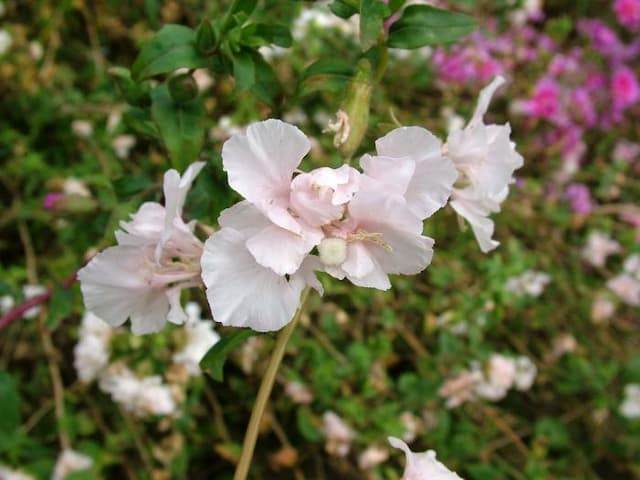Fuchsia Fuchsia 'Royal Velvet' (d)

ABOUT
Fuchsia 'Royal Velvet' is a stunning cultivar known for its striking and ornamental flowers. This plant displays pendulous blooms, which are elegantly poised as if hanging like dainty earrings from the stems. These blooms are characterized by their vivid coloration, typically a deep purple or near-black hue that can appear almost velvety in texture, giving rise to the plant's name 'Royal Velvet'. The inner petals, or corolla, contrast beautifully with the darker outer sepals, often sporting a rich magenta or fuchsia shade that adds an extra layer of depth to the flower's appearance. The flowers are tubular and dainty with a graceful, elongated shape that ends in flared skirts. The foliage of Fuchsia 'Royal Velvet' provides a lush backdrop for the dramatic flowers. Leaves are typically green, sometimes with a faint blue or grayish tint that complements the intense colors of the blooms. The leaves are oval to slightly elongated with a serrated edge, creating a textured look that adds visual interest even when the plant is not in bloom. The foliage can create a dense appearance, offering a continual flush of green that serves as a fresh contrast to the vibrant tones of the blossoms. This ornamental variety is prized for its unique and captivating flowers which can be a focal point in containers, hanging baskets, or garden borders.
About this plant
 Names
NamesSynonyms
Royal Velvet Fuchsia, Lady's Eardrops
Common names
Fuchsia 'Royal Velvet'
 Toxicity
ToxicityTo humans
Fuchsia 'Royal Velvet', commonly known as Fuchsia, is not considered toxic to humans. In general, Fuchsias are not known for having toxic properties that would lead to poisoning if ingested. However, as with any plant material, individual reactions can vary, and ingesting plant parts is not advisable. There are no well-documented symptoms of poisoning from Fuchsias as they are not recognized for being harmful to humans.
To pets
Fuchsia 'Royal Velvet', commonly referred to as Fuchsia, is considered non-toxic to pets, including dogs and cats. There is no significant risk of poisoning if pets inadvertently consume parts of this plant. Nevertheless, consuming non-food items can occasionally lead to gastrointestinal upset in some animals, such as vomiting or diarrhea, so it is prudent to prevent pets from eating this or any ornamental plant as a precaution.
 Characteristics
CharacteristicsLife cycle
Perennials
Foliage type
Deciduous
Color of leaves
Green
Flower color
Mixed
Height
1-2 feet (30-60 cm)
Spread
1-2 feet (30-60 cm)
Plant type
Shrub
Hardiness zones
9
Native area
Central and South America
Benefits
 General Benefits
General Benefits- Ornamental Value: Fuchsia 'Royal Velvet' is highly valued for its vibrant and pendulous purple-red flowers that add a touch of elegance to gardens and patios.
- Attracts Pollinators: This plant attracts hummingbirds and butterflies, promoting biodiversity in your garden.
- Shade Tolerance: It thrives in partial shade, making it suitable for planting under taller plants or in shadier garden areas.
- Container Gardening: It is well-suited for pots and hanging baskets, providing flexibility in garden design and space usage.
- Long Blooming Season: Fuchsia 'Royal Velvet' has a long flowering period from spring to fall, offering sustained beauty throughout the seasons.
- Drought Resistance: Once established, it can be quite resilient to short periods of drought, reducing the need for frequent watering.
 Medical Properties
Medical PropertiesThis plant is not used for medical purposes.
 Air-purifying Qualities
Air-purifying QualitiesThis plant is not specifically known for air purifying qualities.
 Other Uses
Other Uses- Fuchsia 'Royal Velvet' can be used as a natural dye for fabrics, yielding a range of purple and pink hues depending on the mordant used.
- Its blooms can be crystallized and used as edible decorations on cakes and desserts, adding a touch of elegance and color.
- The plant can serve as a learning tool for botany students who wish to study the unique structure of Fuchsia flowers.
- Fuchsia 'Royal Velvet' can be incorporated into sensory gardens as it has visually stimulating flowers and a texture that invites touch.
- Photographers may use the striking appearance of the Fuchsia 'Royal Velvet' as a subject for macro photography to capture the intricate details of its blooms.
- The plant can be employed in creating natural potpourri mixes, with its dried flowers adding color and a light, pleasant scent.
- Fuchsia 'Royal Velvet' can be used in art projects, such as pressing the flowers for inclusion in botanical collages or herbarium collections.
- It may serve as an indicator species in gardens, as Fuchsia flowers often attract specific types of pollinators, reflecting the health of the local ecosystem.
- The pendulous nature of the Fuchsia 'Royal Velvet' flowers makes them ideal for kinetic garden sculptures or hanging mobiles that move with the wind.
- In floral arrangements, the distinctive drooping flowers can add an exotic and luxurious feel to bouquets or table centerpieces.
Interesting Facts
 Feng Shui
Feng ShuiThe Fuchsia is not used in Feng Shui practice.
 Zodiac Sign Compitability
Zodiac Sign CompitabilityThe Fuchsia is not used in astrology practice.
 Plant Symbolism
Plant Symbolism- Confiding Love: Fuchsias are known to symbolize trust and confiding love, representing a deep connection where secrets and innermost thoughts can be shared.
- Elegance and Good Taste: The 'Royal Velvet' variety, in particular, with its rich, velvety petals, suggests sophistication and a refined aesthetic sense.
- Ambiguity and Contradiction: The unique shape of the fuchsia flower, often seen as a blend between a teardrop and a tutu, can represent complexity and the coexistence of opposing ideas.
 Water
WaterFuchsia, commonly known as Lady's Eardrops, benefits from consistent moisture, so it should be watered when the top inch of soil feels dry to the touch. This might mean watering once or twice a week, depending on climate and weather conditions, but be careful not to overwater as they are sensitive to waterlogging. During the growing season, an average of about 1 gallon of water per week is appropriate, with adjustments made for very hot or dry periods. The soil should feel moist at all times, but not soggy.
 Light
LightLady's Eardrops thrive in bright, indirect light with protection from the harsh afternoon sun. The best spot for this plant is one that receives morning sunlight and dappled shade in the afternoon, such as an eastern-facing window or a location with filtered light. Avoid placing them in full shade, as this will hinder their growth and flower production.
 Temperature
TemperatureLady's Eardrops prefer a cooler climate and do best in temperatures ranging between 55 and 75 degrees Fahrenheit. They can tolerate short periods of higher temperatures, but their ideal range is fairly narrow. Keep them away from extreme temperatures, as anything below 40 degrees or above 80 degrees can be harmful to the plant.
 Pruning
PruningPrune Lady’s Eardrops to maintain a compact shape and encourage bushier growth. Trimming should be done in late winter or early spring before new growth begins. Remove any dead or damaged wood, and cut back by a third to promote branching. Regularly pinching out the tips of stems during the growing season also helps stimulate fuller growth and more flowers.
 Cleaning
CleaningAs needed
 Soil
SoilFuchsia 'Royal Velvet', or hardy fuchsia, prefers a well-draining soil mix high in organic matter. A suitable mix can be made with one part peat moss or coco coir, one part loam, and one part perlite or fine bark. The ideal soil pH should be mildly acidic to neutral, ranging from pH 6 to 7.
 Repotting
RepottingHardy fuchsia should be repotted every two to three years or when it has outgrown its current container. It's best to repot in early spring before new growth begins.
 Humidity & Misting
Humidity & MistingHardy fuchsia thrives in moderate to high humidity levels. Aim for a humidity level around 60-70% for optimal health and flowering.
 Suitable locations
Suitable locationsIndoor
Keep in bright indirect light and maintain high humidity.
Outdoor
Plant in dappled shade, shelter from strong winds.
Hardiness zone
6-9 USDA
 Life cycle
Life cycleThe life of Fuchsia 'Royal Velvet', a perennial flowering plant, begins with seed germination, which takes place in warm, moist soil, typically in spring or early summer. Following germination, the seedling emerges and begins vegetative growth, developing a root system and foliage as it matures into a young plant. Throughout the growing season, the plant undergoes vigorous growth, producing distinctive purple-red flowers that hang pendulously from the branches, attracting pollinators such as hummingbirds and bees. After the flowering period, if pollination is successful, the plant will form small, dark purple fruits that contain seeds for the next generation. As temperatures drop in autumn, the plant's growth slows down, and it may become dormant in regions with cold winters, or it may continue to grow in milder climates. The life cycle can be perpetuated by new seeds or vegetatively through cuttings taken from the parent plant to start new individuals.
 Propogation
PropogationPropogation time
Spring-Early Summer
Propogation: Fuchsia 'Royal Velvet', commonly known as fuchsia, is typically propagated during the late winter or early spring, before the plant begins its active growth phase. The most popular method of propagation is through stem cuttings. To do this, a healthy, non-flowering shoot is selected and a cutting of about 2 to 4 inches (5 to 10 centimeters) is taken. The bottom leaves of the cutting are removed, and the cut end is dipped in rooting hormone powder to encourage root growth. The cutting is then placed in a pot filled with a mix of peat and perlite, ensuring that the leaf nodes where the leaves were removed are buried in the soil. The pot is covered with a plastic bag or placed in a propagator to maintain high humidity and kept in a warm place with indirect light until roots develop, which typically takes a few weeks. Once the cuttings have rooted and show signs of new growth, they can be potted on into individual pots.









